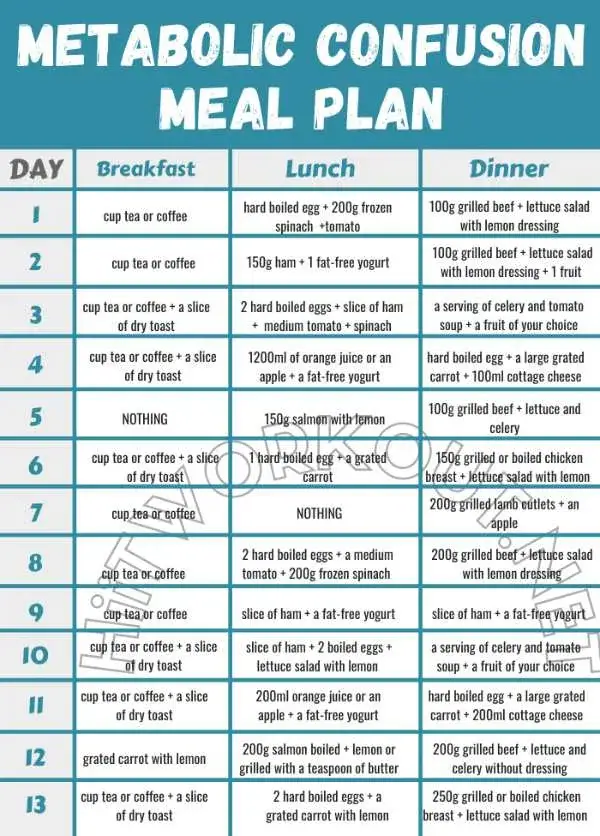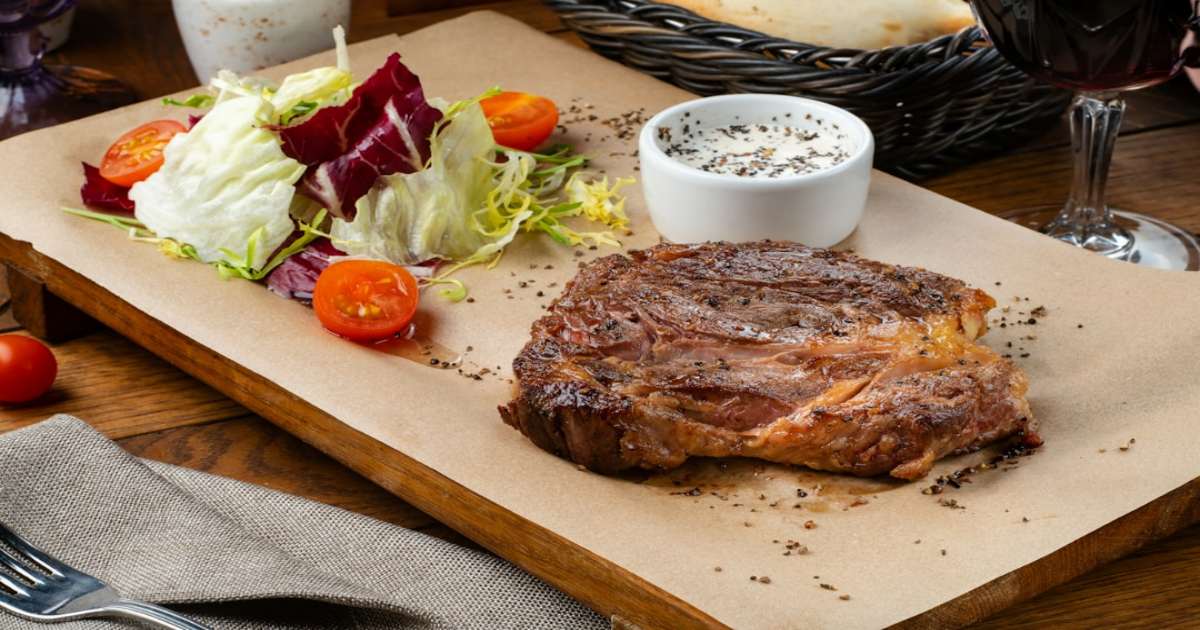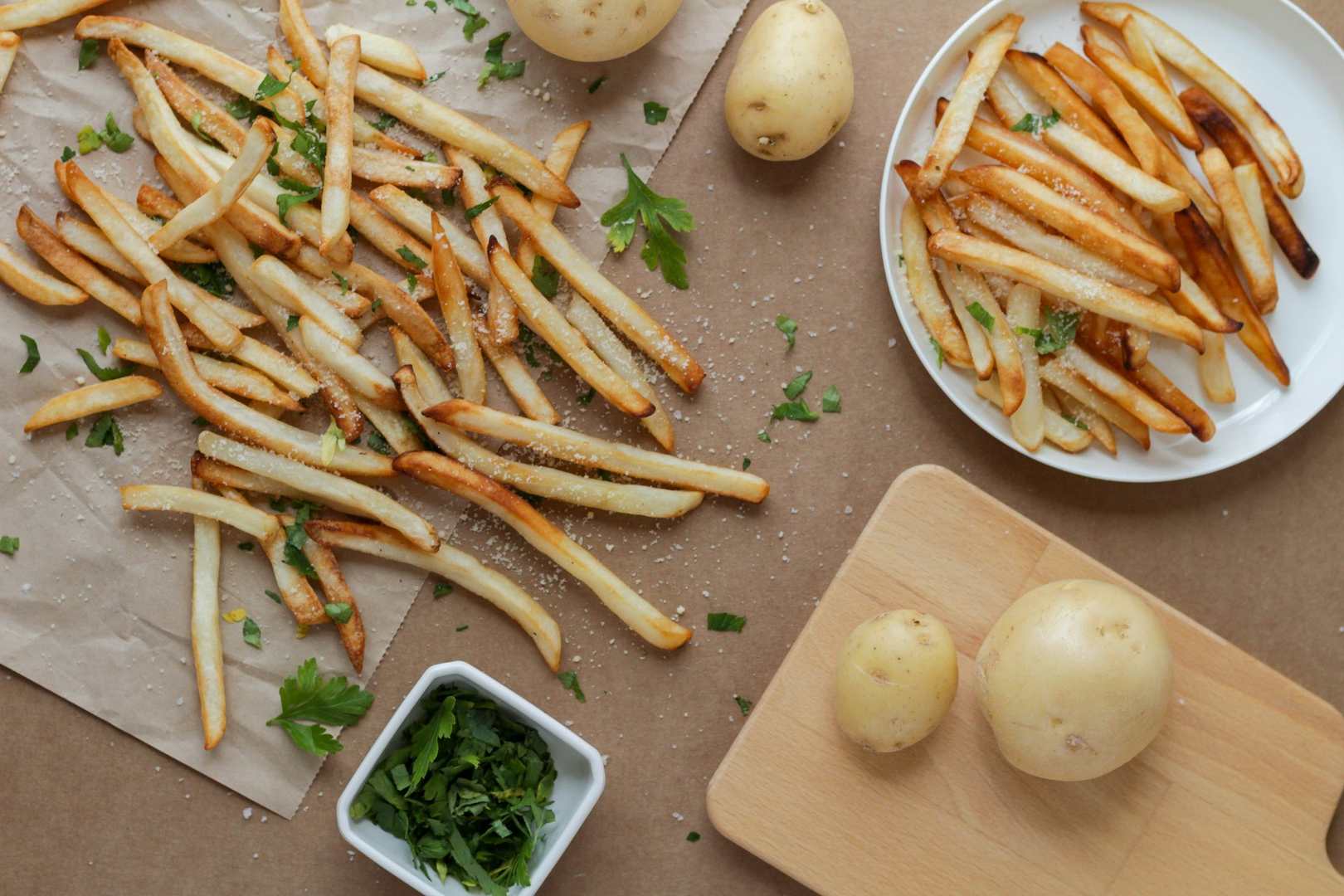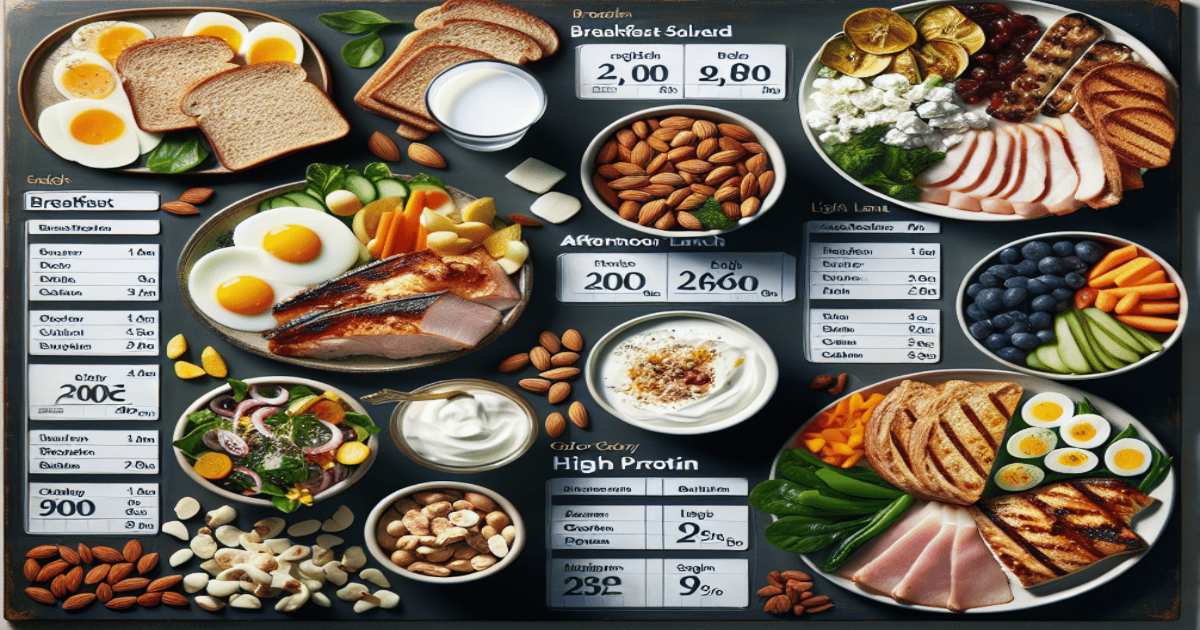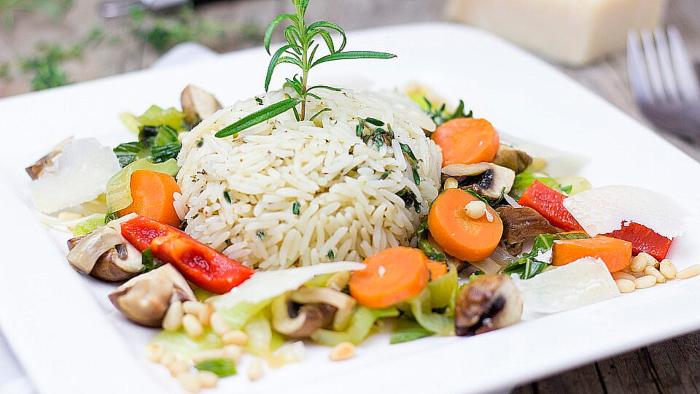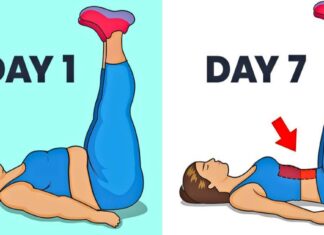Navigating the world of dieting can be a complex task. With countless plans and strategies available, it’s easy to feel overwhelmed.Enter the Metabolic Confusion Meal Plan. This innovative approach to dieting has been gaining traction in recent years.
The premise is simple yet intriguing. By varying your caloric intake, you can potentially ‘confuse’ your metabolism, potentially aiding in weight loss.
This article aims to demystify the Metabolic Confusion Meal Plan. We’ll delve into the science behind it, compare it to traditional dieting methods, and provide a step-by-step guide to implementing it.
Whether you’re a fitness enthusiast or someone looking for an alternative dieting method, this guide is for you. Let’s embark on this journey to understand and potentially harness the power of metabolic confusion.
What Is Metabolic Confusion?
Metabolic confusion, also known as calorie cycling, is a dietary approach that involves varying your caloric intake. The idea is to keep your metabolism guessing, hence the term ‘confusion’.
The theory behind this approach is rooted in the concept of metabolic adaptation. This is the body’s natural response to prolonged periods of consistent caloric intake, which can lead to a plateau in weight loss.
By introducing variation in your daily caloric intake, metabolic confusion aims to prevent this adaptation. The result? Your metabolism stays active, potentially aiding in weight loss and fat burning.
It’s important to note that metabolic confusion is not about eating whatever you want. It’s about strategic variation in caloric intake, while still maintaining a balanced and nutritious diet.
Understanding metabolic confusion is the first step in implementing this dietary approach. In the following sections, we’ll delve deeper into the science behind it and provide a practical guide to creating your own Metabolic Confusion Meal Plan.
The Science Behind Metabolic Confusion
The science behind metabolic confusion is based on the body’s adaptive nature. When you consume the same amount of calories consistently, your body adjusts its metabolic rate to match this intake.
This metabolic adaptation can be a roadblock in weight loss efforts. Your body becomes efficient at using the calories you provide, leading to a slowdown in weight loss or even a plateau.
Metabolic confusion aims to disrupt this adaptation. By varying your caloric intake, you keep your metabolism on its toes. The body can’t adapt to a constantly changing energy supply, so it keeps burning calories at a higher rate.
This approach is also believed to help preserve muscle mass during weight loss. When the body is in a caloric deficit, it can start breaking down muscle for energy. But with metabolic confusion, the higher calorie days can help prevent this muscle loss.
While the science behind metabolic confusion is promising, it’s important to remember that everyone’s body responds differently. What works for one person may not work for another. Always consult with a healthcare professional before starting any new diet plan.
Metabolic Confusion vs. Traditional Dieting
Traditional dieting often involves a consistent caloric deficit. You consume fewer calories than your body needs, forcing it to burn stored fat for energy. This approach can lead to weight loss, but it also has its drawbacks.
One major issue is the metabolic adaptation we discussed earlier. Your body adjusts to the lower calorie intake, slowing down your metabolism. This can lead to weight loss plateaus and make it harder to lose weight over time.
Metabolic confusion, on the other hand, aims to avoid this issue. By varying your calorie intake, you keep your metabolism guessing. This can potentially lead to more sustained weight loss and less likelihood of hitting a plateau.
However, it’s important to note that metabolic confusion is not a magic bullet. It’s just another tool in your weight loss toolbox. It may work well for some people, but not for others. Always consult with a healthcare professional before starting any new diet plan.
How to Implement a Metabolic Confusion Meal Plan
Implementing a metabolic confusion meal plan involves a few key steps. The first step is to calculate your daily caloric needs. This will be the basis for your meal plan.
Next, you’ll need to structure your meal plan. This involves deciding how many meals you’ll eat each day and how you’ll distribute your calories. You’ll also need to consider your macronutrient balance.
Finally, you’ll need to create your meal plan. This involves choosing foods that fit your caloric and macronutrient needs. It’s also important to consider your personal preferences and dietary restrictions.
Remember, the goal of metabolic confusion is to vary your calorie intake. So, your meal plan should include days with higher and lower calorie intake. This will help keep your metabolism guessing and potentially boost your weight loss efforts.
Calculating Your Caloric Needs
To calculate your daily caloric needs, you can use an online calculator. These calculators take into account your age, sex, weight, height, and activity level. They provide an estimate of how many calories you need to maintain your current weight.
To lose weight, you’ll need to consume fewer calories than this number. However, with metabolic confusion, you’ll be varying your calorie intake. So, some days you’ll eat less than this number, and some days you’ll eat more.
Remember, these calculators only provide estimates. It’s important to listen to your body and adjust your calorie intake as needed.
Structuring Your Meal Plan
When structuring your meal plan, consider how many meals you’ll eat each day. Some people prefer three meals a day, while others prefer smaller, more frequent meals. Choose what works best for you.
Next, decide how you’ll distribute your calories. On high-calorie days, you might choose to have larger meals. On low-calorie days, you might choose to have smaller meals or skip a meal.
Remember, the goal is to vary your calorie intake. So, your meal plan should include both high-calorie and low-calorie days. This will help keep your metabolism guessing.
Sample Metabolic Confusion Meal Plan Template
Here’s a sample metabolic confusion meal plan template for a 13 day This is just a guide, and you should adjust it to fit your personal needs and preferences.
Day 1: High Calorie Day
- Breakfast: Avocado toast with scrambled eggs and a side of fruit
- Snack: Greek yogurt with berries and almonds
- Lunch: Grilled chicken salad with mixed greens, tomatoes, cucumbers, and balsamic vinaigrette
- Snack: Apple slices with almond butter
- Dinner: Baked salmon with quinoa and roasted vegetables
Day 2: Low Calorie Day
- Breakfast: Overnight oats with almond milk, chia seeds, and berries
- Snack: Carrots and hummus
- Lunch: Turkey and cheese wrap with lettuce, tomato, and mustard
- Snack: Hard boiled egg
- Dinner: Zucchini noodles with marinara sauce and turkey meatballs
Day 3: High Calorie Day
- Breakfast: Protein pancakes with banana and peanut butter
- Snack: Cottage cheese with pineapple and walnuts
- Lunch: Grilled cheese sandwich with tomato soup
- Snack: Protein shake with almond milk and banana
- Dinner: Beef stir-fry with brown rice and vegetables
Day 4: Low Calorie Day
- Breakfast: Egg white omelette with spinach, mushrooms, and feta cheese
- Snack: Celery and peanut butter
- Lunch: Tuna salad with whole grain crackers
- Snack: Edamame
- Dinner: Baked chicken with sweet potato and steamed broccoli
Day 5: High Calorie Day
- Breakfast: Breakfast burrito with scrambled eggs, black beans, avocado, and salsa
- Snack: Protein bar
- Lunch: Grilled shrimp skewers with quinoa and roasted vegetables
- Snack: Banana with almond butter
- Dinner: Whole wheat pasta with marinara sauce and turkey meatballs
-
Day 6: Low Calorie Day
- Breakfast: Greek yogurt with granola and berries
- Snack: Cucumber slices with hummus
- Lunch: Turkey and cheese sandwich with lettuce, tomato, and mustard
- Snack: Hard boiled egg
- Dinner: Baked salmon with quinoa and steamed vegetables
Day 7: High Calorie Day
- Breakfast: Protein waffles with berries and maple syrup
- Snack: Cottage cheese with pineapple and almonds
- Lunch: Grilled chicken wrap with lettuce, tomato, and ranch dressing
- Snack: Protein shake with almond milk and banana
- Dinner: Beef stir-fry with brown rice and vegetables
Day 8: Low Calorie Day
- Breakfast: Egg white omelette with spinach, mushrooms, and feta cheese
- Snack: Carrots and hummus
- Lunch: Tuna salad with whole grain crackers
- Snack: Edamame
- Dinner: Baked chicken with sweet potato and steamed broccoli
Day 9: High Calorie Day
- Breakfast: Avocado toast with scrambled eggs and a side of fruit
- Snack: Greek yogurt with berries and almonds
- Lunch: Grilled chicken salad with mixed greens, tomatoes, cucumbers, and balsamic vinaigrette
- Snack: Apple slices with almond butter
- Dinner: Baked salmon with quinoa and roasted vegetables
Day 10: Low Calorie Day
- Breakfast: Overnight oats with almond milk, chia seeds, and berries
- Snack: Celery and peanut butter
- Lunch: Turkey and cheese wrap with lettuce, tomato, and mustard
- Snack: Hard boiled egg
- Dinner: Zucchini noodles with marinara sauce and turkey meatballs
Day 11: High Calorie Day
- Breakfast: Protein pancakes with banana and peanut butter
- Snack: Cottage cheese with pineapple and walnuts
- Lunch: Grilled cheese sandwich with tomato soup
- Snack: Protein bar
- Dinner: Whole wheat pasta with marinara sauce and turkey meatballs
Day 12: Low Calorie Day
- Breakfast: Greek yogurt with granola and berries
- Snack: Cucumber slices with hummus
- Lunch: Tuna salad with whole grain crackers
- Snack: Edamame
- Dinner: Baked chicken with sweet potato and steamed broccoli
Day 13: High Calorie Day
- Breakfast: Breakfast burrito with scrambled eggs, black beans, avocado, and salsa
- Snack: Protein shake with almond milk and banana
- Lunch: Grilled shrimp skewers with quinoa and roasted vegetables
- Snack: Banana with almond butter
- Dinner: Beef stir-fry with brown rice and vegetables
Remember, this is just a template. You can adjust the calorie levels and the distribution of high and low-calorie days to fit your needs. The key is to keep your metabolism guessing by varying your calorie intake.
Tips for Success with Metabolic Confusion
Success with metabolic confusion requires more than just varying your calorie intake. It also involves careful meal planning and a balanced approach to nutrition. Here are some tips to help you succeed with metabolic confusion.
First, be consistent. While you’re varying your calorie intake, it’s important to stick to your meal plan. This will help keep your metabolism guessing and boost your weight loss efforts.
Second, be patient. Weight loss takes time, and it’s normal to experience plateaus. Don’t get discouraged if you don’t see immediate results.
Finally, listen to your body. If you’re feeling hungry or low on energy, it might be a sign that you need to adjust your calorie intake. Remember, the goal is to fuel your body, not starve it.
Meal Timing and Frequency
Meal timing and frequency can play a role in metabolic confusion. Some people find success with eating smaller, more frequent meals. Others prefer three larger meals a day.
The key is to find what works best for you. Experiment with different meal timings and frequencies to see what keeps you feeling satisfied and energized.
Remember, the goal of metabolic confusion is to keep your metabolism guessing. So, don’t be afraid to mix things up and try different meal timings and frequencies.
Macronutrient Balance
Macronutrient balance is another important aspect of metabolic confusion. This involves balancing your intake of protein, carbs, and fats.
On high-calorie days, aim for a balance of all three macronutrients. On low-calorie days, focus on lean protein and veggies to keep you feeling full.
Remember, the goal is not to eliminate any one macronutrient. Instead, it’s to vary your intake to keep your metabolism guessing.
Incorporating Physical Activity
Physical activity is a key component of any weight loss plan, including metabolic confusion. It can help boost your metabolism and aid in weight loss.
Try to incorporate both cardio and strength training into your routine. Cardio can help burn calories, while strength training can help build muscle and boost your metabolism.
Remember, the goal is to keep your body guessing. So, vary your workouts just like you vary your calorie intake. This can help keep your metabolism high and aid in weight loss.
Common Myths and Misconceptions
There are several myths and misconceptions about metabolic confusion. One common myth is that it’s a quick fix for weight loss. In reality, metabolic confusion is a long-term strategy that requires consistency and patience.
Another misconception is that metabolic confusion involves extreme calorie restriction. This is not the case. While you do vary your calorie intake, you should never starve yourself. The goal is to fuel your body, not deprive it.
Finally, some people believe that metabolic confusion means you can eat whatever you want on high-calorie days. This is not true. It’s still important to focus on nutrient-dense foods and maintain a balanced diet.
Adjusting the Plan for Your Needs
A metabolic confusion meal plan is not a one-size-fits-all approach. It’s important to adjust the plan based on your individual needs and progress. For instance, if you’re not losing weight, you may need to decrease your calorie intake.
On the other hand, if you’re feeling fatigued or hungry all the time, you may need to increase your calories. Remember, the goal is to fuel your body and support your metabolism, not to starve yourself.
Lastly, consider your lifestyle and preferences. If you prefer larger meals, you might opt for fewer, higher-calorie days. If you prefer smaller meals, more low-calorie days might work better for you.
Free Metabolic Confusion Meal Plan PDF
To help you get started, we’ve created a free Metabolic Confusion Meal Plan PDF. This guide includes a sample meal plan, tips for success, and answers to common questions.
FAQs About Metabolic Confusion
Many people have questions when they first hear about metabolic confusion. Here are answers to some of the most common queries.
Is metabolic confusion safe? Generally, yes. But it’s always best to consult with a healthcare professional before starting any new diet plan. They can help ensure it’s a good fit for your individual health needs.
Can I use metabolic confusion with other dieting strategies? Yes, metabolic confusion can be used in conjunction with other dieting strategies, such as intermittent fasting. However, it’s important to listen to your body and adjust as needed.
What if I hit a plateau with metabolic confusion? Plateaus are common in any weight loss journey. If you hit a plateau with metabolic confusion, it may be time to reassess your caloric needs and adjust your meal plan accordingly.
Is metabolic confusion suitable for vegetarians or vegans? Absolutely. The principles of metabolic confusion can be applied to any dietary preference. The key is to ensure you’re getting a balance of macronutrients within your caloric range.
Conclusion and Call-to-Action
Metabolic confusion meal plan offers a unique approach to dieting. By varying your caloric intake, you may be able to boost your metabolism and potentially enhance weight loss. Remember, it’s not a quick fix but a lifestyle change that requires patience and consistency.
If you’re ready to give metabolic confusion a try, why not start today? Begin by calculating your caloric needs and structuring your meal plan. Listen to your body, adjust as needed, and don’t forget to incorporate physical activity.
To help you get started, download our free Metabolic Confusion Meal Plan PDF. It’s a comprehensive guide that will support you on your journey to better health.
Keep reading: Golo diet: You Can Lose 20 Pounds In 2 Weeks With This Free Meal Plan!



